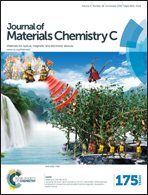A study of Ce3+ to Mn2+ energy transfer in high transmission glasses using time-resolved spectroscopy
Abstract
This work investigates the energy transfer from Ce3+ to Mn2+ in high transmission glass (HTG) doped with CeO2 and MnO through time-resolved spectroscopy to transform the solar spectrum into a more efficient red-enhanced spectrum for traditional Si-based solar cells. We show that both Mn3+ and Mn2+ and Ce3+ and Ce4+ centres are formed in HTG through their absorption and emission/excitation spectra. Interestingly, Ce3+ excitation at 320 nm yields both Ce3+ (400 nm) and Mn2+ (530 nm) emissions for doping concentrations of 0.1–1% Ce3+ and 0.1% Mn2+. The energy transfer process in HTG is noteworthy since it enhances the capability for blue-to-red light transformation, which is important for a concentrator in photovoltaic applications. This work analyses the non-radiative vs. radiative Ce3+ → Mn2+ energy transfer process in this optically enriched HTG. In the explored doping range we show that energy transfer is purely radiative.


 Please wait while we load your content...
Please wait while we load your content...